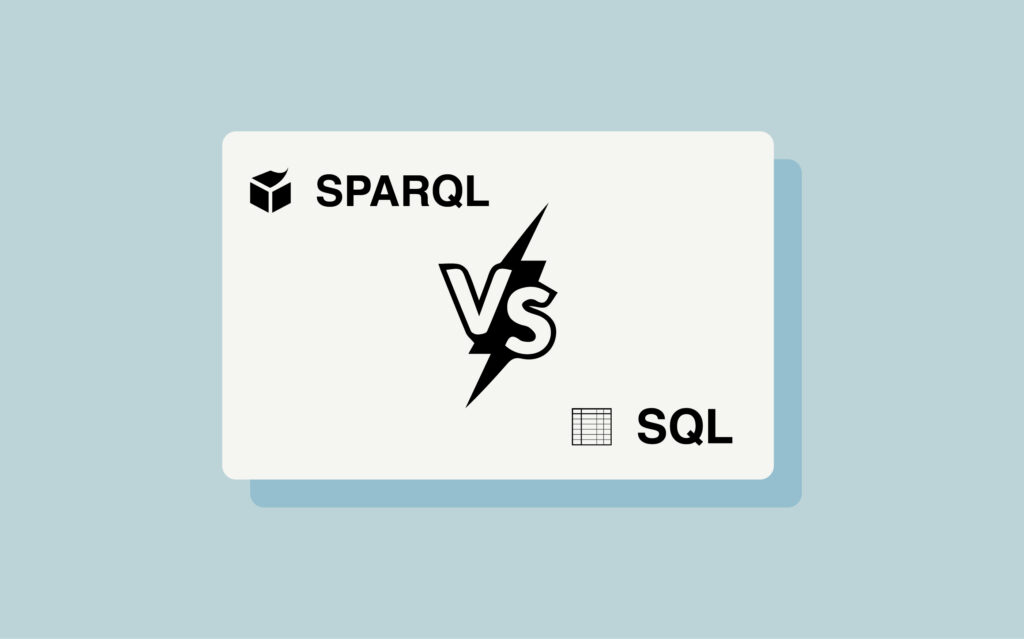SPARQL and RDF are both powerful tools for modelling and querying data on the World Wide Web. Learn how they work together to enable flexibility and interoperability.
As organisations grow, so does their data. Even if it becomes cheaper and easier to ingest, store, and transform data, without the right data management strategy, data silos rapidly emerge and complicate productivity and cooperation.
Semantic Web is a good approach to tackling the problem of data integration using RDF (Resource Description Framework) and leveraging the power of linked and open data.
By using RDF it is possible to build highly interconnected, interoperable, and flexible information structures.
RDF is a W3C standard for representing data on the web. It is based on the idea of representing data as a structure of triples (subject-predicate-object). RDF data is usually stored inside knowledge graphs, and to access, query, edit, and manipulate these knowledge graphs, several tools are available.
One of the most popular is SPARQL (SPARQL Protocol and RDF Query Language).
SPARQL is a query language for retrieving and manipulating data stored in RDF. It is similar in purpose to SQL (Structured Query Language) which is used for relational databases but is designed specifically for the RDF data model.
What are the differences between SPARQL and SQL?

SPARQL and SQL are both query languages, used for performing various operations on a database, such as inserting, updating, and retrieving data.
But they are used for different purposes and have some key differences.
Data model
One of the main differences between the two languages is the type of data they are used to query. SPARQL is a query language for retrieving and manipulating data stored in RDF (Resource Description Framework) a W3C standard for representing information as triples (subject-verb-predicate structure) inside knowledge graphs.
It is similar to SQL (Structured Query Language) in that it allows for querying and manipulating data, but it is designed specifically for querying RDF data.
SQL is used to query relational data, which is organized into tables with rows and columns.
Syntax of the query
Another difference is the syntax of the languages.
SQL has a more traditional, declarative syntax, and supports a limited set of query types, such as SELECT, INSERT, UPDATE, and DELETE.
While SPARQL has a more complex, graph-based syntax, and supports a more diverse set of query types, including SELECT, ASK, CONSTRUCT, DESCRIBE, and also INSERT, UPDATE, DELETE.
SQL is used to describe what the desired outcome should be, rather than specifying the steps to achieve it. While SPARQL has a more complex, graph-based syntax that allows for querying data that is distributed across multiple sources.
SPARQL may be more difficult to learn and use, but it allows for more powerful and flexible querying of RDF data.
Data Integration
SQL is designed to join data in a tabular format, while SPARQL is designed to join data from multiple sources, allowing one to join data from different RDF datasets.
SPARQL is more flexible than SQL when joining data from multiple sources because of the RDF data model.
Why are RDF and SPARQL often used together?
One of the key advantages of using RDF and SPARQL together is the ability to create linked data.
RDF triples provide a way to connect resources on the web, allowing for easy navigation and discovery of related information. This is particularly useful for data integration, publication and analysis, as it allows for the connection of data from multiple sources.
While SPARQL allows users to write complex queries across multiple RDF knowledge graphs, including the ability to query for specific data, filter results, and join data across multiple resources.
This makes a powerful combination for working with linked data.
RDF provides a standardized way to model and describe resources, while SPARQL allows for the querying and manipulation of that data.
RDF and SPARQL are used in a wide variety of applications, including the semantic web, linked data, data integration, and data publication. They are supported by a growing number of RDF databases and Knowledge Graphs, with advanced features such as filtering, sorting, and aggregation.
At Cognizone, we understand the full potential of knowledge graph databases built upon RDF data and using SPARQL’s flexibility and interoperability, as well as the ability to connect and use Linked Data. We strive to share our knowledge and skills, and this is a great opportunity to share our expertise on this powerful set of tools and their role in the Linked Data and Semantic Web space.
We appreciate the time you took out of your day to read this article and we hope you find it informative!
You can find more articles on our blog and while you’re there, look at our resources and insights about building an effective Enterprise Knowledge Graph.
For news and insights find us on Twitter @cognizone
Interested in integrating RDF data or in training in SPARQL? Contact us at info@cogni.zone
We are a specialist consultancy with long experience in designing and implementing Enterprise Knowledge Graphs in government and other data-intensive sectors. Through our combination of technical skills, industry practitioners, and expertise in open and linked data, we can help you see data challenges from a new perspective.




